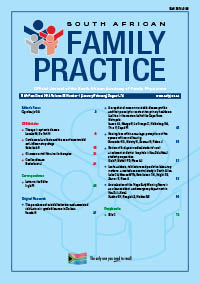The prevalence of suicidal behaviour and associated risk factors in grade 8 learners in Durban
Keywords:
suicidal behaviour, age range 13-15 years, Durban, South Africa
Abstract
Objectives: Most of the research on suicidal behaviour in youth focuses on developed countries. Less is known about the prevalence of suicidal behaviour and associated risk factors in community samples of youth who do not present for mental health care in developing countries. This study investigated the prevalence of suicidal behaviour and associated risk factors in grade 8 learners in Durban. Setting and subjects: Grade 8 learners in a government-run, co-educational school were approached to participate in the study after parental consent and child assent were obtained. A descriptive, cross-sectional method was used to gather quantitative data. The grade 8 learners were asked to complete demographic questionnaires and various psychometric assessment scales. Design: The gathered data were divided into two groups, i.e. those who reported personal suicidal behaviour and those who did not. The various variables in these two groups were compared using bivariate and multivariate statistical analyses. Results: The study established that 22 participants (33.8%, n = 75) reported suicidal behaviour (thoughts, plans or attempts in this regard). They also had higher levels of depression, perceived stress, hopelessness and anger (p-value < 0.01) than those who did not report any suicidal behaviour. The same participants had lower scores on scales that assessed self-esteem and perceived social support from family (p-value < 0.01), compared to those who did not report any suicidal behaviour. Logistic regression analysis that was undertaken indicated that a friend’s suicidal thoughts [odds ratio (OR) 4.27, p-value < 0.01], alcohol use (OR 3.08, p-value < 0.01), perceived stress (OR 1.05, p-value < 0.01) and depression (OR 1.04, p-value < 0.01), were strong predictors of personal suicidal behaviour in this sample. Conclusion: There is a high prevalence of suicidal behaviour in grade 8 learners in Durban. The identified risk factors were similar to those found in developed countries. Healthcare providers and other professionals, such as school counsellors, should consider the identified risk factors when assessing suicidality and planning interventions for youth.
Published
2013-08-01
Section
Original Research
By submitting manuscripts to SAFP, authors of original articles are assigning copyright to the South African Academy of Family Physicians. Copyright of review articles are assigned to the Publisher, Medpharm Publications (Pty) Ltd, unless otherwise specified. Authors may use their own work after publication without written permission, provided they acknowledge the original source. Individuals and academic institutions may freely copy and distribute articles published in SAFP for educational and research purposes without obtaining permission.

